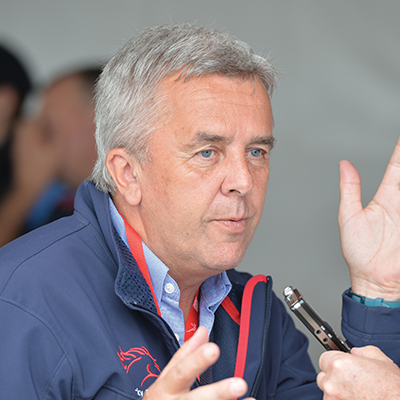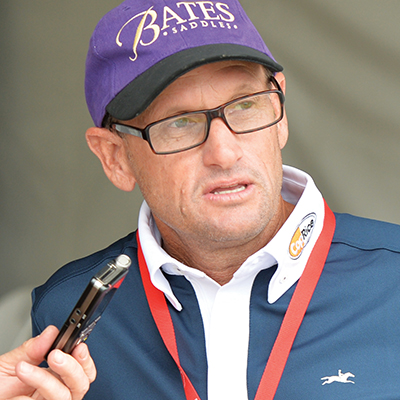 TALKING WITH MIKE ETHERINGTON SMITH
TALKING WITH MIKE ETHERINGTON SMITH
Michael Etherington Smith is the world’s greatest course designer, he has that magic touch of creating tracks that let the best-of-the-best rise to the top, while at the same time taking care of the less experienced combinations in the field. Mike ES has been working on the Sydney course for the last couple of years having been the designer who put it in place at the beginning for the Sydney Olympic Games. As usual, he has a clear vision of where he is going:
“This year to be honest, we ended up on Plan B, which sort of slightly upset the balance of the track and softened it a bit, but at least we had a competition which was the most important thing. What I am trying to do over a period of time is create versatility so that course designers here can have lots of options and flexibility as to where to take the course. So bit-by-bit we are creating some new lines, new routes. We used the inside of the steeplechase course – it took about ten months of working on permissions to do it! – and we can now join one side of the park to the other by going through the steeplechase course.”
“I did some plans last year, on how to join up the park, and as the budget allows it, that’s the plan.”
Were you surprised how well the ground stood up to the weather this year?
“Not really, I knew how it was prepared for the Games. I was quietly confident during the week. Sure there are wet spots and soft spots, but we moved the fences on to essentially dry land, the best possible ground we could find. You watched the horses traveling, they weren’t getting stuck in it, the horses were coming out of it well. I suppose the challenge here is that the horses aren’t used to that sort of ground, but they soon adapted and most coped really really well. One or two struggled a bit, whether that was the ground or they were just a bit green… but watching the horses traveling down the hills, they weren’t backing off, they were running down the hills as you would expect them to. I wasn’t surprised how it held up, I wouldn’t have wanted to put three times the number of horses around it though, to be honest. If we’d had eighty in the class it would have been busier.”
I guess you’ve read Jim Wofford’s piece on the web, I would particularly like your comments on his suggestion that the modern courses have so many fences that require precise jumping that the riders are slowing down to take those lines and then have to travel way too fast to make up time and that is leading to problems on ‘easy’ fences…
“Wof is a really good guy, a real thinker, and I have a huge amount of respect for him – he’s a good mate as well. He is a real observer and there is a lot in what he says. We’ve been talking about it for a while, you’ve got to be very careful: the standard in the dressage and showjumping gets much higher, but what you must be mindful of, is that while they get higher, the focus doesn’t solely rest on the dressage and jumping, because the horses have to find a fifth leg for the cross country, and if they are waiting for instruction all the time, it’s not good. You get on a cross country course, riders make mistakes, horses make mistakes, they have to be able to work it out for themselves. It’s no good them waiting for an instruction from the riders.”
“One of the things we are mindful of, is that we want to encourage people to go and practice their cross country. The top guys do practice their cross country, they get out on the grass so the horses know where their feet are, and they understand that it is not always perfect ground. I think what Wof has said is absolutely right, the style of cross-country courses has changed, but the sport has changed. We don’t have roads and tracks and steeplechase, so the endurance element has disappeared.”
“Because the standard has grown, big, straightforward, run-and-jump fences on their own, don’t separate out those that are right on the top of the sport from those on the way up. It is getting harder for course designers to put the emphasis on the cross-country course in a fair way. You can be unfair, which is not pretty, you can over-do the accuracies and the corners, but there is a balance in there.”
“What we’ve got to do is get people used to jumping the sort of questions they are going to find at the higher level when they are competing at the lower levels. Managing speed is part of that balance, course designers can only do so much. As a course designer you want to allow the horse and the rider to settle into a rhythm, grow in confidence and benefit from the experience. You don’t want to mess them around, and you don’t want interruptions on a course, it must flow. Okay there are going to be gear changes but you don’t want the horses having to go from nothing on a regular basis because that is physically tiring.”
“You also want to be very conscious of the mental effect of the course and its impact. If you look at Badminton last year, many of the fences were absolutely fine, one or two that caught Giuseppe Della Chiesa (course designer) out, but the overall package was too much mentally – too many gear changes, too many interruptions. There is no easy solution to the point that Jimmy has highlighted. Each course designer has his own signature, but you want riders to be able to keep traveling.”
“We put a speed gun on some horses in California a few years ago, 800 metres a minute, and you think, bloody hell! A lot of those guys are – I’m not going to say uneducated, but they have missed the point of getting into a rhythm and staying in that rhythm and allowing the horses to just run and jump the fences. You look at the really good guys in the sport, they are into that rhythm. There is no slowing down before the fence, they let the horses jump out of a rhythm and they maintain the average speed.
They don’t have to do these ludicrous speeds in between the fences to try and get the time. Sprinting from one sequence of fences to another is just not pretty and it is not what we as course designers want to do.”
“We want to achieve a balance and a flow to the course that allows riders to get into that groove and stay in it. Watch the good guys, they are in that groove, and they waste no time going into the fences or getting away from them, and they are not going fast, they are within their comfort zone. We can only do so much as course designers, we must be very mindful of the product we are putting out there, but equally riders must be sure that they have the skills they need to emulate the top riders.”
“I’m not a coach and I wouldn’t pretend to know how to get that into the riders, but it is a balance and we all have a responsibility in this. I think Jimmy has highlighted a really topical issue, and he articulated it so well. I didn’t agree with everything in there, but the point that jumped off the page to me was the bit about horses have to be able to think for themselves and not just wait for decisions from the riders. They have to be able to work things out for themselves when a rider makes a mistake, or when they make a mistake because horses make mistakes as well…”
Or when the course designer makes a mistake…
“Course designers make mistakes all the time. We all make mistakes, but we can work together to get the balance right. I love talking to Jimmy, he’s a real thinker, and is very articulate. When Jimmy says something you take note of it, you might not agree, but you sit up, because he doesn’t put pen to paper without really really thinking about it.”
 Stuart Tinney continues to develop his role as a course builder, sitting out this year’s Sydney Three Day to concentrate on his one-star and two-star courses, what did he set out to achieve?
Stuart Tinney continues to develop his role as a course builder, sitting out this year’s Sydney Three Day to concentrate on his one-star and two-star courses, what did he set out to achieve?
“I think what I try to do, certainly with the one-star, but also with the two-star, is remember you are still training the horses at that level. At three-star, you are starting to test them… I think with educating one-star horses, you have got to start introducing them to what they are going to see. You start with accuracy questions, arrowheads, apexes – I try to help them by framing the jumps, to encourage them to jump and not run out. I’m trying to help them learn, but I also don’t want to make it that easy that everyone jumps around clear. You want to test them slightly, but be encouraging and teaching. It is a bit the same with the two-star, it gets a little tougher, I make the lines and angles harder but I am still encouraging them to jump, not teaching them to run out.”
“That’s my philosophy on those lower grades, and then when you get to three-star, four-star, you are testing the training, the horse’s education and honesty.”
Was it much harder as the weather deteriorated…
“The big thing about Sydney with the terrain and the hills is that it is a tough enough course anyway, as soon as you add the going – which was actually incredibly good for the amount of rain we’ve had, and that’s the wonderful thing about this venue, that we could still run the event and still have a successful event even with the most rain in the history of Sydney… I think that added to the course, the horses were quite tired, especially in the CCI classes. What we want to try to do here is actually change the tracks around and get it more flowing and not so hilly. I think we can do that and make it a bit nicer.”
“To be honest I was really happy with how the riders rode, they did a great job, they rode to the conditions, all the horses pulled up well.”
You did the test ride on War Hawk, and had the best score, are you sorry you didn’t give him a run?
“He is headed for his first three star CCI and because of the terrain here, he’ll go to Melbourne for the first one. But in the days before the event, I was a bit disappointed I hadn’t entered him, but it would have been tough for him with the terrain and the going. Still it’s a lovely track that Mike ES has built.”
You must have been pleased with your pupil Makayla Wood having such a great cross country run…
“She was super, I saw her around the cross country at quite a few spots and she looked really good – Thoroughbred mare, she just galloped gorgeous. I’m not surprised, I was hoping she would go like that and not surprised she did.”
If you are interested in Eventing, there are lots more articles on this site – just click ‘eventing’ at the top of this page…


